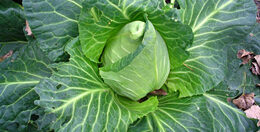
Cabbage
For these members of the vegetable kingdom, it has been found that leaving them in the ground for well into fall/early winter is actually good for them (and for you…) “Cold is often the catalyst that brings on the best flavors.” Privileged members of this clan are: Beets, Brussels Sprouts, Broccoli, Cabbage, Carrots, Chard and Kale.
Will remain online for educational purposes. Operating on a “Hobby” basis.
Occasionally we may have “extra” seed. Pkts. marked below. If nothing marked…then it is “N/A”.
- All Season Succession – (aka A.S. Vandegraw) Round heads with a flattened top. This variety can grow from 9 to 14 pounds. Folks rate this one as having excellent flavor. Withstands heat well, so mulch its roots. 85-95 days from transplant
- Brunswick – Introduced over a 100 years ago in 1876. Heads are very compact (heavy) flattened, 9″ across with weights of almost 9 lbs possible. Was known as an excellent market variety although rarely seen today. A large “drum head” variety showing great tolerance to cold and used exclusively as a winter storage type, as it stores so well. Very rare.
- Danish Ballhead – (aka True Hollander, aka Pennstate) another “goodie” from my friend Micky. Popular heirloom intro. in 1887. This very dependable blue/green roundish var. matures at 5-7lbs. It was bred for storage (which it excels at…) and to endurance Northern type climates. With all these great characteristics, it also resists splitting! An all-purpose cabbage we should not be without! 85-110 days
- Deadon Savoy – Another gorgeous “January King” type cabbage. Improved version as it resists “the Yellows”. Red savoy with light green interiors. Cold weather, as always intensifies its color. Heads are medium to large sized, firm and deliciously sweet.
- Early Jersey Wakefield – originated from the “Wakefields” out of England. Heritage variety produces conical-shaped heads early in the season. Dark green heads have a tender core and texture…for summer meals. Is not a winter variety and will mature at 2 lbs (Can grow to 9″ tall) Plant out as soon as the fertile soil can be worked, in cool weather. 65 days from transplant
- Glory of Enkhutzen – “Introduced by N. V. Sluis en Groot’s Koninklijke Zaadteelt en Zaadhandel of Enkhuizen, Netherlands (an old Dutch seed house). The parentage is reportedly 2 old German varieties – ‘Glückstadter’ and ‘Ditmarscher’ Orig. selected in 1899, the seed was simultaneously released in both Europe and America in 1902. The first company to offer it in the United States was the J. C. Vaughan’s Seed Store, Chicago, Illinois, in 1903.” c/o Victory Seeds
- January King – wow! Turns out this gorgeous heirloom dates back to Victorian England…and that it is a semi-savoy (…if there is such a thing!) A magnificent vegetable worthy of its royal title. Its outer leaves and their fringes are lightly savoy’d that turn deep shades of med. green and purple/plum. Its inside for the most part shows deep green to lite green shades. Is able to tolerate deep cold temperatures without damage, some saying as cold as -10C! Seems its mustard/tangy flavor does a turnabout with the longer it stays cold, becoming sweeter over time. Some say it should be planted in mid-summer as it will perform better in the coolness of the season. (Seems my friend Gloria T. grew these to gi-gantis proportions!)
- Kalibos – Here is the awesome version of a PURPLE “conehead” cabbage! Grew these for a few years and really like the rare color and shape!
- Koda – another purple red oval type, but with tighter heads for late season harvests. Originated in Poland.
- Mammoth Red Rock – introduced in 1889. Solid round heads are 8″ in diameter and weigh about 7 lbs. The red color is prevalent through out. Heads contain a small to medium sized core. A reliable, vigorous and uniform performer with fine flavor. Excellent for cooking, salads & pickling. 98 days from transplant
- Premium Flat (Rock) Dutch – in the catalog of D.M. Ferry & Co. of 1924 it states: “This strain is the result of much care on our part to develop and maintain the good qualities that have made this one so popular.” Solid flat heads are 7″ to 8″ deep and 10″ to 14″ in diameter. A late season variety @ 100 days from transplant. Limited SOLD OUT!
- Winningstadt – first listed in N.A. by J.J. Gregory & Sons of Marblehead, Massachusetts in 1866. Earlier documentation showed it being grown around the Red River settlements in Manitoba in 1864. It was developed from the Brunswick cabbage that was widely grown in the 1700’s. The heads of this variety are pointed, large and dense. It was therefore used extensively for making sauerkraut. Its heads reach 8″ to 10″ tall and 7″ wide. The leaves are thick, bluish-green, firm and waxy. The flavor is outstanding! Great as an “all-around” salad maker. Mature plants can reach outwardly 28″ to 30″ across…as they have by me!!! This one is a winter variety. 90 days…early for this reason.
